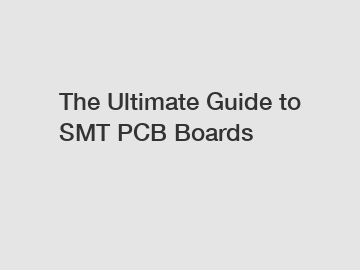The Ultimate Guide to SMT PCB Boards
The Ultimate Guide to SMT PCB Boards.
SMT (Surface Mount Technology) PCB (Printed Circuit Board) boards have revolutionized the electronics industry, enabling manufacturers to build smaller, more powerful, and more reliable devices. In this ultimate guide, we will delve into the world of SMT PCB boards, exploring their origins, the process of their assembly, and the significance they hold in the modern electronic landscape.
Origins of SMT PCB Boards.

The foundation of SMT PCB boards originated in the late 1960s when the demand for smaller, lightweight, and cost-effective electronic devices started to escalate. Traditional through-hole technology, which involved inserting components into pre-drilled holes on the circuit board, was not suitable for the emerging needs. Hence, surface mount technology was developed as a more efficient alternative.
The Assembly Process.
The assembly of SMT PCB boards involves a meticulous process that ensures maximum component density and reliability. Initially, a solder paste is screen-printed onto the PCB, which acts as an adhesive to hold the components in place. Next, high-speed pick-and-place machines accurately position the surface mount components onto the appropriate pads. The final step involves reflow soldering, where the PCBs are passed through a convection oven to melt the solder paste, permanently attaching the components to the board.
Significance and Impact.
The adoption of SMT PCB boards has had a significant impact on the electronics industry, revolutionizing the way devices are designed and manufactured. The key advantages of SMT include:
1. Size Reduction: SMT enables the miniaturization of electronic devices, allowing manufacturers to pack more functionality into smaller form factors. This has led to the development of compact smartphones, tablets, and wearables, enhancing portability and convenience.
2. Improved Performance: The compact size of SMT components reduces parasitic capacitance and inductance, resulting in improved signal integrity and higher operating frequencies. This enables the creation of faster and more powerful electronic devices.
3. Cost-Effectiveness: SMT PCB boards require less material and labor compared to through-hole technology, making them more cost-effective to produce. Additionally, the automated assembly process reduces the chances of human errors and increases production efficiency, ultimately leading to lower manufacturing costs.
4. Reliability: The smaller size and tighter component connections of SMT PCB boards contribute to enhanced reliability. The reduced mechanical stress on components and the elimination of exposed leads minimize the risk of damage during transportation and everyday use.
In conclusion, SMT PCB boards have become the backbone of modern electronics, enabling the development of smaller, more powerful, and reliable devices. Their origins rooted in the need for miniaturization, the assembly process involving solder paste and reflow soldering, and the significance they hold in terms of size reduction, improved performance, cost-effectiveness, and reliability demonstrate their fundamental role in the electronics industry. Embracing SMT technology is crucial for manufacturers and designers seeking to stay ahead in this ever-evolving landscape.
For more Box Turning Conveyor Belt Equipment China Wholesale, Conveyor Stop Gate, Smt Loader Machineinformation, please contact us. We will provide professional answers.

Comments
0